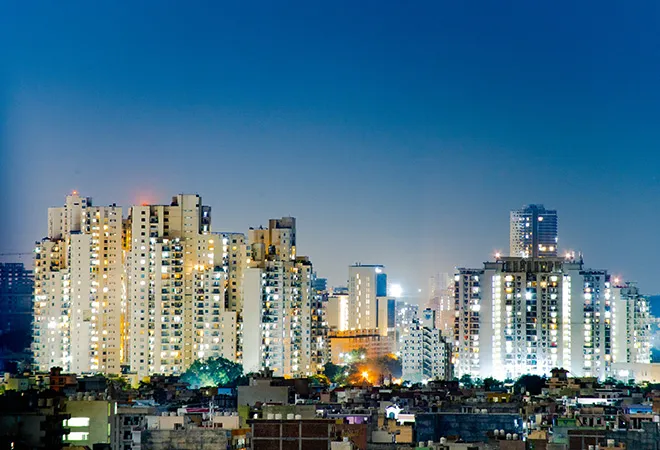-
CENTRES
Progammes & Centres
Location

An analysis of the coronavirus figures indicates that in the frontline of the war against COVID-19 are a handful of urban local bodies (ULBs) that are carrying the overwhelming number of men and women infected by the virus. How successful we would be if this war largely rests on the capacity of the ULBs to fight it. However, the emerging situation does not inspire confidence. ULBs are under severe financial stress. If their finances are not shored up by higher levels of Government, they may soon enough not be in a position to stand up to the challenge.
An earlier ORF article had explained how the COVID-19 pandemic in India, as in the rest of the world, had become an overwhelmingly urban phenomenon. With the passage of time, data on the virus in regard to India reveals that the urbanisation of the pandemic is getting stronger. Maharashtra, Tamil Nadu, Gujarat, Delhi, Rajasthan, Madya Pradesh, Uttar Pradesh, Andhra Pradesh, West Bengal and Punjab – the ten top states with the largest number of COVID-19 cases are either the most urbanised or have some of the largest cities. Together, as of 20 May, they had 100,286 COVID-19 patients or 90.18 percent of India’s total cases of 111,203. All the other states and union territories shared a total of 7,097 cases amounting to 7.4 percent of the virus burden.
Within these states, as of 20 May, the ten top cities had about 66 percent of all cases of India. These are Mumbai (22,563 cases), Delhi (11,088), Ahmedabad (8,945), Chennai (8,228), Thane (4,714), Pune (4,240), Indore (2,565), Jaipur (1,640), Surat (1,156) and Jodhpur (1,110). They are, therefore, at the forefront of the fight against the virus. Preventive health is an obligatory duty of urban local bodies and they are dutybound to deal with the disease.
The worrying part is that it is not the industries and businesses alone that have been battered by the prolonged lockdowns. The municipal corporations have been equally impacted. In fact, the ULBs stand doubly burdened by the disease that has thrust an inordinately large portion of COVID 19 patients to be cared for by the civic administrative machinery. This has made them bear an additional expenditure on account of the virus that must not have been budgeted for by the municipal bodies. This was not all. Their income sources that were very fragile to begin with, have taken a huge hit on account of the cessation of most urban activities.
This article studies the example of Pune, one of the very rich and well-functioning cities in India and the impact COVID-19 has had on its finances and long-term viability. Some time back, the Union Ministry of Urban Affair ranked Pune as the country’s most liveable city among the 111 major cities it surveyed, based on the benchmark of its ‘Ease of Living Index’. Its Pune Smart City Development Corporation (PSCDCL) was declared winner of the Best Smart City award at a Smart city expo in May 2019. However, the pandemic is not destined to leave the city in its current salubrious shape, if the virus continues on the present trajectory for a few more months.
The Pune Municipal Corporation (PMC) approved a budget of Rs. 7,400 crores for the year 2020-21. This budget, approved at the end of February 2020 and prepared a little earlier, had no inkling of the havoc COVID-19 would play on the city. Quite naturally, it did not take into account the factor of the virus on its finances and the additional unbudgeted works it would have to undertake. Their funds were to come from four main sources. Its mainstay, property tax, that showed an annual demand of Rs. 2,800 crores. Development charge - levied on all construction activities in the city was to fetch about Rs. 1,000 crores. It budgeted a receipt of Rs. 1,850 crores that it would receive from the State Government as its share for General Services Tax (GST) and Rs. 240 crores as the share of stamp duty collected in the city.
Under each of these revenue heads, the budget has gone for a complete toss. Its property tax receipts have dipped sharply. Against an estimated receipt of around Rs. 600 crores during the first 45 days of the financial year, it received only Rs. 145 crores. That is a mere one-fourth of the expected amount. Furthermore, requests have started coming from business establishments that payments of this tax be deferred in view of their own desperate condition. In regard to development charge, the almost complete stoppage of construction activity has given the PMC a paltry amount of Rs. 17 lakhs (0.001 percent) against an estimated revenue of Rs. 125 crores for the first one and a half months, April and May, that are peak pre-monsoon construction months. Despite certain relaxations that have been announced post the second phase of the lockdown , Prashant Waghmare, the PMC City Engineer feels that “construction activity is not likely to pick up since builders have been financially seriously hurt and migrant labourers, who primarily work on such projects, have gone away to their home states”. The State has passed on Rs. 25 crores of stamp duty collection to PMC as against an annual target of Rs. 240 crores and an additional Rs. 100 crores of GST share against an annual target of Rs. 1,850 crores. It all adds up to actual receipt of 27 percent against amounts budgeted. Since the State is itself seriously struggling with its finances and liabilities, PMC may not expect its complete share of stamp duty and GST anytime during this year.
To make matters worse, unforeseen expenditures in the form of COVID-19 health care has forced the PMC to incur an unbudgeted expenditure of around Rs. 70 crores. In the top list of cities, Pune has the sixth largest number of COVID-19 patients after Mumbai, Delhi, Ahmedabad, Chennai and Thane. Additional amounts would have to be pumped in as the rising number of patients escalate the health care bill.
In the given situation, what are the options before the PMC? The corporation has a monthly salary bill of around Rs 100 crores that would have to be paid. Most maintenance jobs will have to be undertaken lest the city services get seriously run down. However, it would have to defer developmental works that the budget had indicated. The city corporation has Rs 1,500 crores of fixed deposits that it can tap as a last resort. It may choose to defer payment of Rs. 260 crores that it annually owes to Maharashtra State Electricity Distribution Company Ltd (MSEDCL). However, a city as robust as Pune, with all these adjustments, may not survive for too long if the virus refuses to quieten and hangs around in the city for a considerable length of time. Galinde, the Municipal Chief Auditor and former Chief Accountant of PMC opines that “at the current rate, PMC will face a liquidity crisis in about six months”.
The situation cannot be much different in the other major cities that are bearing the brunt of the corona fight. Indeed, many of the cities among the worst affected by the pandemic, such as those in Madhya Pradesh and Rajasthan, do not have the kind of money available to PMC. The Union Finance Minister has announced five tranches of assistance to a host of organisations so that the economy can be got back on its rails. It may, however, run into a roadblock of financially failing cities unable to carry on the fight against the pandemic. Government of India and the states would be well advised to take some action before the situation goes out of hand.
The views expressed above belong to the author(s). ORF research and analyses now available on Telegram! Click here to access our curated content — blogs, longforms and interviews.

Dr. Ramanath Jha is Distinguished Fellow at Observer Research Foundation, Mumbai. He works on urbanisation — urban sustainability, urban governance and urban planning. Dr. Jha belongs ...
Read More +